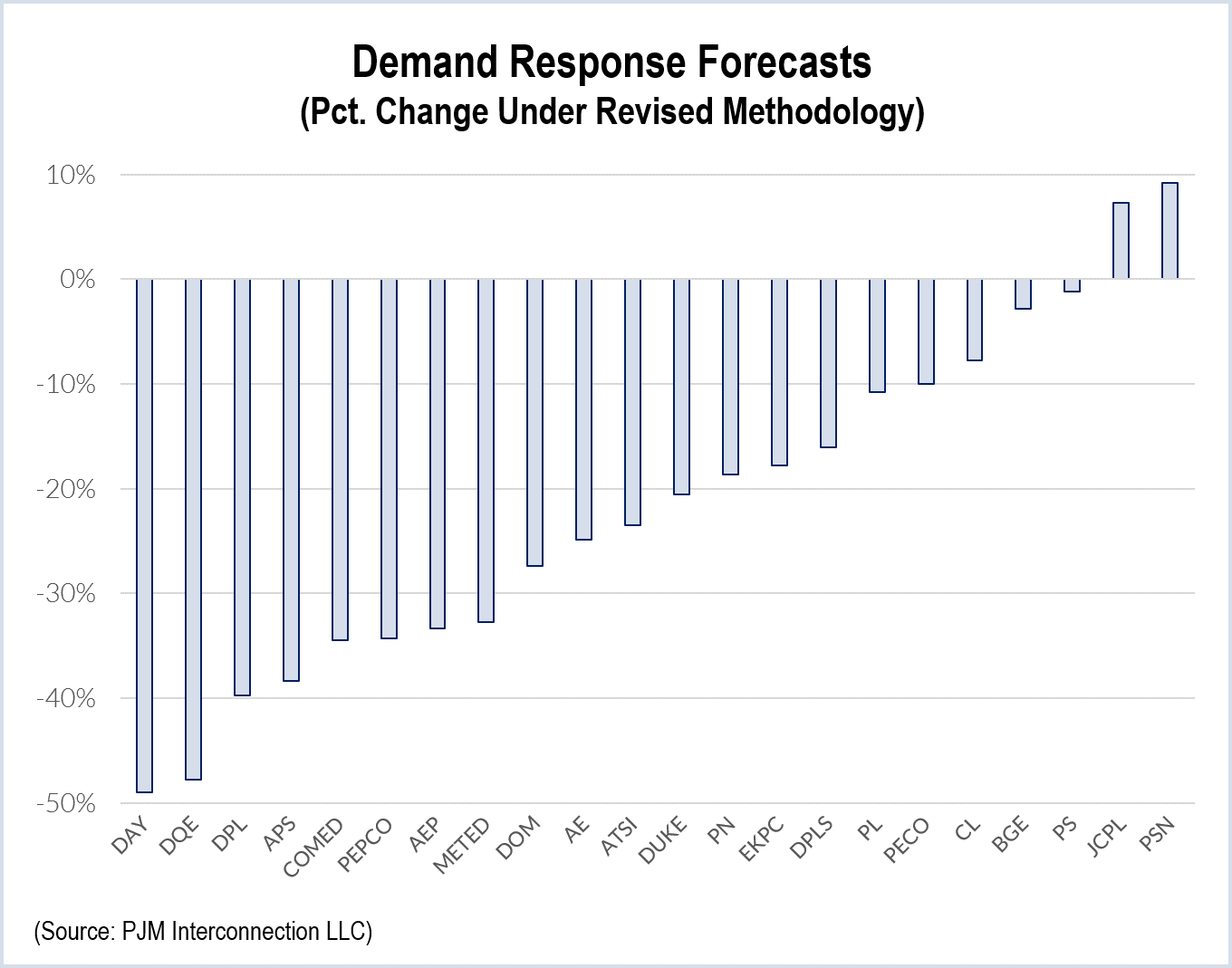VALLEY FORGE, Pa. — Demand response forecasts used in PJM planning studies will drop in all but two of 22 transmission zones under a methodology change endorsed by the Planning Committee last week.
According to a PJM analysis, 10 zones will see drops of 25% or more for delivery year 2020, with the Dayton Power and Light (DAY) and Duquesne Light (DQE) zones falling by almost half (see chart). RTO-wide, forecast DR for delivery year 2020 would drop by one-quarter to 8,200 MW from 11,100 MW.
The current load deliverability analysis uses the amount of DR that has cleared in the last base residual auction to project DR available five years in the future. But PJM officials say that a significant amount of DR that clears the auction is replaced by other resources before the delivery year arrives. In the 2014/15 year, 46.5% of the DR assumed to be available had been replaced by non-DR resources. (See Change Proposed in PJM Demand Response Modeling.)
The new method will base future forecasts on an average of the final amount of committed DR for the most recent three years. The average would be expressed as a percentage of the zone’s 50/50 summer peak forecast for application to future years’ demand.
“All that matters in this method is what has historically committed, not what has cleared in any particular auction,” said Tom Falin, PJM manager of resource planning.
If approved by the Markets and Reliability Committee this month, PJM will begin using the new methodology in the 2015 Regional Transmission Expansion Plan.
Falin said the new method is unlikely to have much practical impact, at least in the short term.
A reduction in forecast DR will increase the assumed load of locational deliverability areas (LDAs), resulting in an equivalent increase in the LDA’s capacity emergency transfer objective (CETO) — the amount of power it must be able to import during a localized capacity emergency while remaining within a loss-of-load expectation of one event in 25 years.
Planners compare the CETO level with the LDA’s capacity emergency transfer limit (CETL), the maximum amount of power the transmission system can deliver into the LDA.
For the May 2015 capacity auction, all LDAs have CETO/CETL margins in excess of 115%, large enough that the DR forecast changes are unlikely to impact the areas’ reliability requirements.
“We seem to have very healthy CETO/CETL margins,” Falin said. “The practical impact of this change may not be all that great.”
Change Would Shift Baseline Upgrades to Network Customers
PJM wants to change how it studies long-term firm transmission service requests to ensure individual requesters share in the cost of transmission upgrades required to serve them.
PJM’s Aaron Berner told the Planning Committee on Thursday that the “pancaking” of individual requests sometimes results in a need for reinforcement projects but that the current study process results in the cost of such improvements being assessed broadly on load customers and transmission owners through baseline upgrades rather than on individual requesters through network upgrades.
Berner outlined a proposed problem statement that will be brought to a vote at next month’s committee meeting.
Changes Proposed for Light Load, Wind Modeling
PJM planners are considering lowering the light-load modeling assumption from 50% to 35% of the summer peak based on an analysis that showed a significant number of hours of lower load.
PJM’s light-load period is 1 a.m. to 5 a.m. from Nov. 1 through April 30 of each planning year. Planners said their analysis of three years of data found loads in the MAAC, ComEd and Dominion zones are only 35% of peak load during a significant number of hours.
At the same time, planners are considering increasing the maximum wind ramping from 80% to 100%, which is consistent with the modeling in its neighbor MISO. Five transmission owner zones — AEP, APS, COMED, PENELEC and PL — contain wind generation. Between 2001 and 2014, average maximum wind capacity for the five zones was 92.5%.
PJM will conduct sensitivity analyses on the proposed changes and report back to the Planning Committee. (See Light-Load Study: Generation Up, Load Down.)
PJM Seeks to Revise Definitions in Merchant Network Upgrades
PJM will seek to revise three definitions in the Tariff that it says are making it difficult to properly process requests for merchant network upgrades. Under a problem statement endorsed by the PC, PJM would consider changes to the definitions of “Upgrade Request,” “Customer-Funded Upgrade” and “Merchant Network Upgrades.”
Planners said the current definitions have sometimes resulted in higher-priority interconnection projects negating a merchant network upgrade request.
— Suzanne Herel


